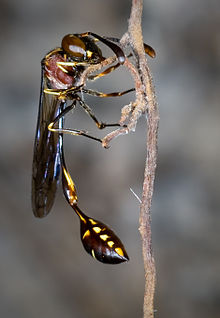Hover wasp
| Stenogastrinae | |
|---|---|
 |
|
| female of Parischnogaster mellyi | |
| Scientific classification | |
| Kingdom: | Animalia |
| Phylum: | Arthropoda |
| Class: | Insecta |
| Order: | Hymenoptera |
| Family: | Vespidae |
| Subfamily: | Stenogastrinae |
| Genera | |
|
|
The Stenogastrinae are a subfamily of social wasps included in the family Vespidae. They are sometimes called hover wasps owing to the particular hovering flight of some species. Their morphology and biology present interesting peculiarities.
The first reports on stenogastrine wasps can be found in a book of Guérin de Méneville (1831) with the first known species, Stenogaster fulgipennis. Henri Louis Frédéric de Saussure treated their systematic position and remarked that these wasps were, in all their characters, entirely intermediate between the two subfamilies of Eumeninae and Vespinae. In 1927, Anton von Schulthess-Rechberg created the new genus Parischnogaster for some species living in the Oriental region.
Dutch entomologist Jacobus van der Vecht created four new genera including species from the entire area of distribution and described tens of new species. He revised the two Papuan genera Anischnogaster and Stenogaster and the oriental genus Metischnogaster while the largest genera of the Oriental region, Liostenogaster and Eustenogaster, still wait for revision. He also created one more genus, Holischnogaster, which has been then synonymised by Carpenter (1982) with Parischnogaster. A seventh genus, Cochlischnogaster, described by two Chinese entomologists (Dong and Otsuka), has been more recently included in the subfamily. Carpenter made overviews of the taxonomy and phylogeny of the group which he treated as a subfamily of the family Vespidae. The Stenogastrinae, Polistinae and Vespinae are sister groups and derive from a common ancestor. A recent, more complete analysis from the same author including biomolecular data confirms this phylogeny.
The length of the body varies between 10 (some species of Parischnogaster) and 25 mm (some Eustenogaster species). The colour is usually dark brown with brilliant black shades mixed with yellow, white, or yellowish spots. The wings sometimes have iridescent reflexes. Characteristic is the gastrum, the first segment of which is represented by a long petiole blunted in its posterior part.
The shape of the head, viewed from the front, is subtriangular owing to the very long mandibles. The compound eyes are great, and the clypeus is usually quite pointed. The antennae are generally clavated. The mandibles are much more subtle with respect to those of polistine or vespine wasps: in the females they can have three teeth, but in the males of some species, their internal margin is almost straight.
...
Wikipedia
